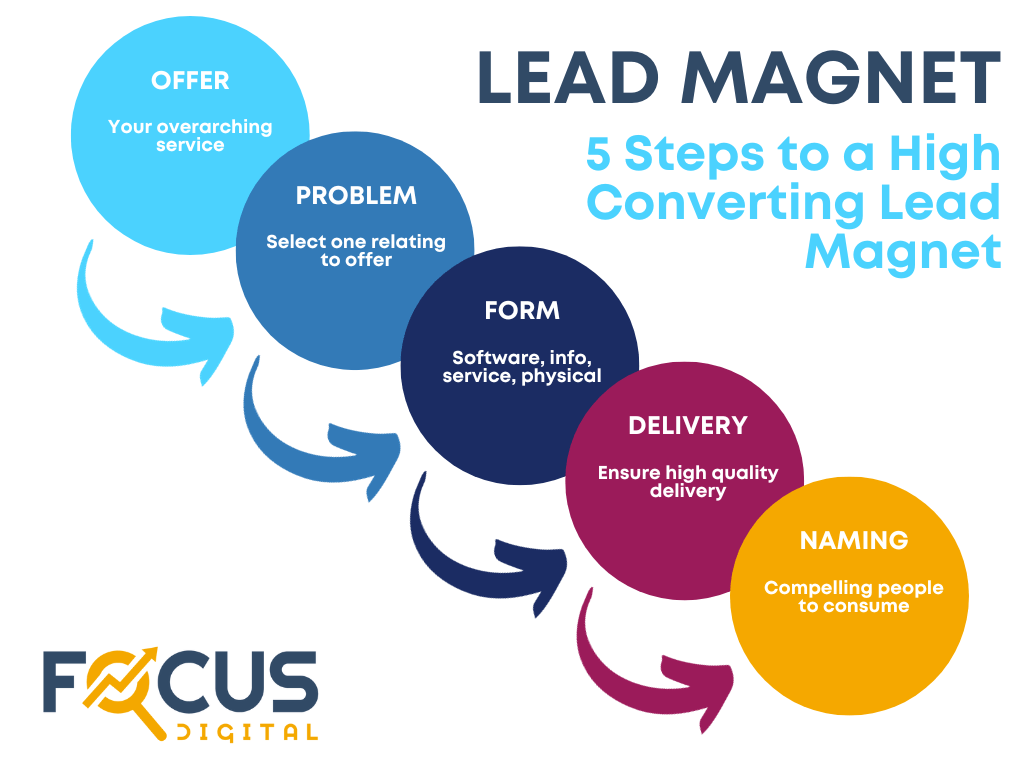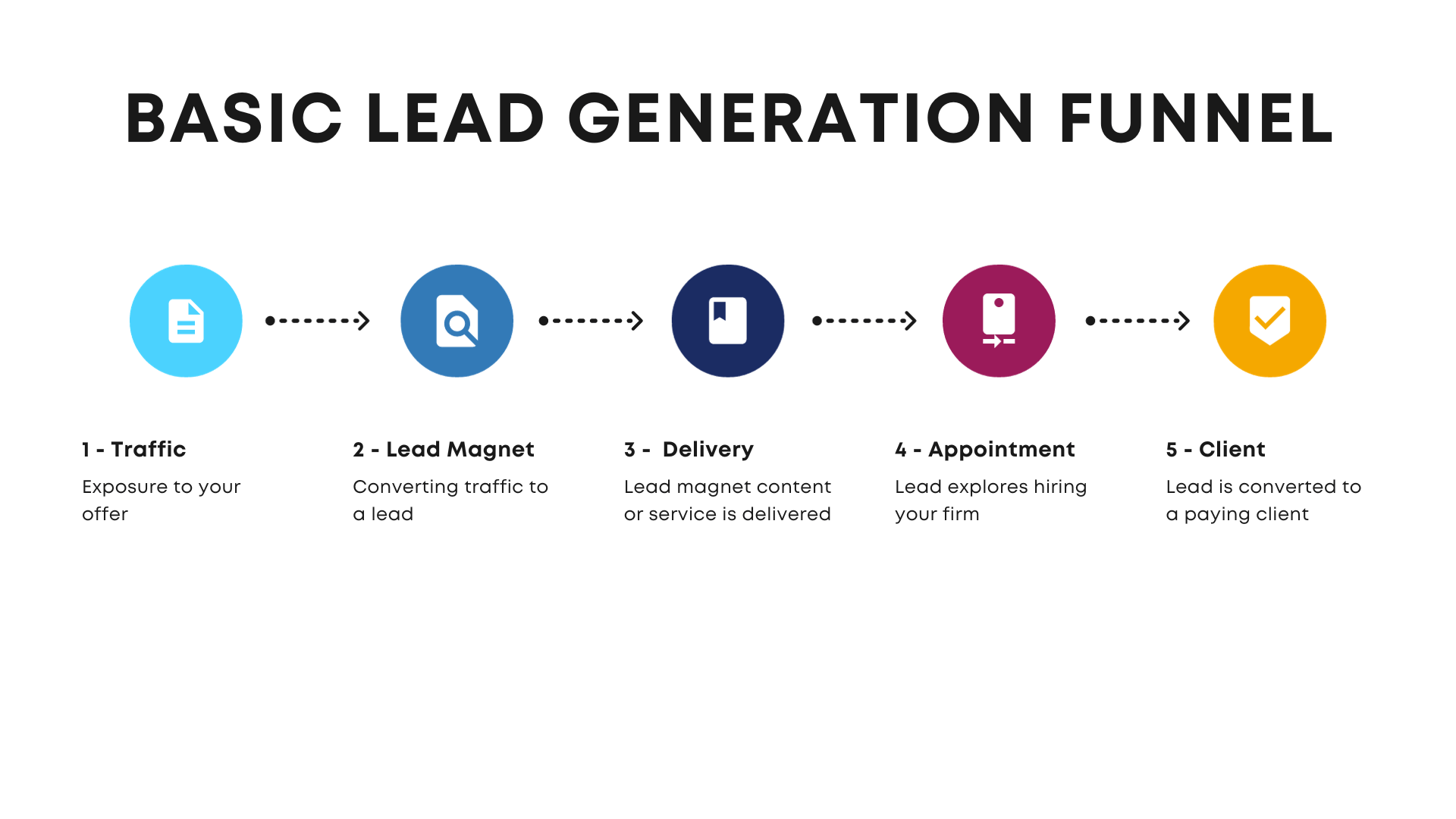Estimated Reading Time: 8 minutes
We’ve compiled a “how-to” guide on lead generation for accounting firms. What to expect:
- Full lead generation strategy explained
- Creating a compelling lead magnet
- Two ways to drive traffic to your landing page
Full Lead Generation Strategy Explained
Step 1: Traffic
The first step to generating leads for accounting is building a sustainable traffic source. Traffic, simply put, are visitors to your website or social media pages. Once they are on your pages, we present them with an offer. A percentage of those visitors will take you up on your offer, and thereby move to the next stage of the funnel.
Step 2: Lead Magnet
A lead magnet is a complete solution to a narrow problem you give potential customers for free or at a significant discount. The next section will cover the best practices for creating a lead magnet. Here is an example of a lead magnet:

As you can see, this lead magnet would attract this firm’s ideal customer, but would not give away enough information where the firm would not be needed.
Step 3: Delivery
The delivery stage of the lead magnet is crucial. You must provide a complete solution to a narrow problem. This allows your firm to display competence without eliminating the need for your potential customers to hire you. Lead magnets can be delivered in the form of:
- Software: This can be a special calculator or other small piece of technology such as a spreadsheet.
- Information: Taking the form of an interview, keynote presentation, mini-course, or other means of delivering information to potential customers.
- Services: This involves performing a free service such as a free consultation to the potential client in hopes of gaining their trust and their business.
- Physical Products: A physical product could be a book, chart explaining an accounting process, or other type of physical means of transferring information.
Step 4: Appointment
Once a lead has consumed the lead magnet, the next stage is to set them up for an appointment. This is the final stage before a lead converts into a customer. At this point, a lead should have experienced the value you have to provide from your lead magnet. At the appointment, the concerns are not whether you can provide value for them, but rather whether you are a good fit to work together.
Step 5: Client
This is the most self-explanatory stage. At this point, the focus should be on incredible service delivery. Satisfied clients can be leveraged for referrals and testimonials, which will bolster your lead generation.
Creating a Compelling Lead Magnet

There are five primary steps to creating a lead magnet, and a lead magnet will be the primary mechanism of converting traffic into leads.
Step 1: Offer
First, you must decide on the service you are attempting to generate leads for. If the lead magnet does not stem from the core offer, the leads you generate will not relate to what you offer them next.
The offer must be a logical extension of the lead magnet you offer. If you offer a report on tax planning, do not expect the leads to be interested in auditing services. A good test is to ask yourself “Would someone who realistically wants my main service sign up for this lead magnet?”
Step 2: Problem
A lead magnet, in its essence, is a complete solution to a narrow problem. For example, if your offer is tax planning, you may choose to offer a complete solution or guide to how much a small business owner can claim as a home office deduction.
Ideally, you want to give away enough information for a lead to know and trust you, but not enough to eliminate the need for your services. To continue the tax planning example, there are a multitude of problems you solve as a tax planner. But, you may choose to focus on the home office deduction for the lead magnet, in which case you should give them every piece of information they need to claim the deduction correctly.
Providing high-quality lead magnets breeds goodwill, and goodwill leads to customers. Next, we’ll discuss the creation of the lead magnet.
Step 3: Form
As discussed above, there are four primary ways to package a lead magnet. They are as follows:
- Software: This can be a special calculator or other small piece of technology such as a spreadsheet.
- Information: Taking the form of an interview, keynote presentation, mini-course, or other means of delivering information to potential customers.
- Services: This involves performing a free service such as a free consultation to the potential client in hopes of gaining their trust and their business.
- Physical Products: A physical product could be a book, chart explaining an accounting process, or other type of physical means of transferring information.
Select the form that you believe will best serve your potential customers and most clearly convey the information. Continuing the tax planning example, here is how you could make the home office deduction lead magnet in each of the forms:
- Software: Offer a spreadsheet or other calculator allowing people to calculate how large of a deduction they may take for business use of their home.
- Information: Film a walkthrough video of Form 8829 explaining how to file the form and giving examples.
- Services: Give potential clients 15-minute consultations where you help them calculate their home office deduction.
- Physical Products: Ship them a guidebook on business use of the home and offer suggestions to maximize the deduction.
Regardless of your choice, ensure this is a complete solution to the problem you promised to solve in the lead magnet.
Step 4: Delivery
This stage involves reaching out to leads and monitoring the lead magnet to ensure people are satisfied with the information and genuinely find it valuable. If leads are not converting to appointments and sales after they have consumed your lead magnet, most likely the lead is either not satisfied with the content of the lead magnet or you have not strategized correctly regarding the lead magnet being attractive to your ideal customer.
Step 5: Naming
The final step is to test and optimize the name of the lead magnet to convert higher amounts of traffic. The name should convey that they will receive the solution to their problem, but it will come down to testing which name will work the best. Some ways to determine which is the best name for your lead magnet are to ask clients, coworkers, other accountants, and people potentially in the market. You could also split-test your landing pages (where traffic goes to access your lead magnet) to ascertain which name is the best.
A few potential lead magnet names:
- How to calculate the business use of home deduction
- Run your business from home? Here’s how to take a tax deduction from it
- Small Business Owners: Use your home to save money on taxes
For a lead magnet to be valuable, traffic has to view it, so you can generate leads. Below, we cover our two favorite ways to push traffic to your lead magnet.
Two Ways to Drive Traffic to Your Landing Page
Our team recommends two means of driving traffic to your landing page. One of these is organic, meaning it will take longer for traffic to build, and the other is inorganic paid advertising, which will provide immediate traffic. Organic advertising traditionally has a long-term higher ROI than paid advertising, but both can deliver sustainable returns for a business.
Method 1: Google Ads
Google Ads, or PPC advertising, is our recommended paid method for acquiring traffic. The ROI is quick and allows you to test different lead magnets quickly to determine which will deliver the highest ROI for your business. On average, accounting firms can see a 3:1 return on Google Ads.
Method 2: Search Engine Optimization
Search Engine Optimization, SEO for short, is the art of providing Google with the highest quality response to various high-intent search queries in exchange for traffic from Google. Once traffic has come to your website in a blog, you can direct them to your lead magnet. This form of marketing takes longer to ramp up, but long-term accounting firms see returns as high as 9:1.
Click here to view our full guide for SEO for accountants.
ROI Over Time: Google Ads vs SEO
ROI Over Time - SEO & PPC
Time SEO PPC 1 Month -100.00% 303.00% 3 Months -66.70% 309.09% 6 Months -16.70% 318.46% 9 Months 37.10% 328.10% 12 Months 148.30% 337.05% 18 Months 370.70% 358.91% 24 Months 593.10% 380.92% 30 Months 815.50% 404.27% 36 Months 1037.90% 425.72%
Next Steps
If you have any questions about the article or are looking to work with a professional to execute a lead generation strategy, consider reaching out on our Contact Us page to begin a conversation.
